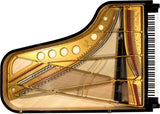Steingraeber & Söhne D-232 vleugel
| Length (cm) | 232 |
| Width (cm) | 157 |
| Branch | Veenendaal |
Price on request: please Contact for more information.
The new Steingraeber & Söhne D-232, the "little" brother of the E-272 concert grand piano, was introduced in 2008 at music exhibitions in California, Frankfurt and Paris. At first glance, the 'family' resemblance to the E-272 wing is immediately recognizable in the shape of the outer edge. Both the D and E models include the same excellent acoustic properties, such as the symmetrically shaped edge with a good reflection zone at the rear, a unique design that optimally uses the soundboard.
The result is a tone that is present and sings. At second glance, extraordinary features become apparent: - The D-232 has the lightest top cover of any wing. Up to 33% lighter than industrially prepared lids! This contributes to additional overtones in the core of the sound. - The largest range in pitch is achieved by the special capo d'astro bar that runs to forty-six choirs, to just above the middle of the keyboard. This concept is unique to Steingraeber and nowhere else in the world is this used in a grand piano . Only forty-two choirs pass through graves!
The goal of the Steingraeber piano builders is to give more clarity, even more shine and a beautiful singing tone. Steingraeber pianos are already praised for this! It goes without saying that the "7-feet-7" (as the D-232 is called in America) also comes with a well-known Steingraeber specialty, the drilled capo d'astro bar. This contributes to structural stability and sustain in the wing. Thanks to twenty to twenty-five grams of upweight and a downweight of 48 g in the treble and 52 g in the bass side, playing is more fun, lightning fast, or controllable down to the softest pianissimo. Light hygroscopic mineral material and solid ebony black keys complete the complete feel of this grand piano. The D-232 is a thoroughly classic, professional concert grand piano. Special features such as the innovative Phoenix system of patented bridge agraven for energy-efficient transmission are available for all Steingraeber grand pianos.
Top quality wood
The quality of the wood is of vital importance for a piano maker and Steingraeber & Söhne does not take any risks. It is stored at a carefully controlled and constant humidity of 40%. For soundboards, Steingraeber exclusively uses 'Bergfichte•, slowly grown spruce wood with the annual rings close together, which is at least 250 years old. "The soundboard is not only an amplifier, but also the source of the sound. Therefore, the resonance of the wood must correspond to the register of the piano for which it is used. The solid red and white beech wood used for the combs, after entering the factory it is left to rest for another three years before being processed.
Principles of classical keyboard construction
To achieve optimal results, everything is assembled in the studios at Steingraeber & Söhne, down to millimeters:
Soundboard, bridge and cast iron frame are adjusted to the soundboard and not the other way around. The frame is first coated with paint and from the print on the tuning block (which, depending on the model, consists of 20 to 32 layers of beech wood) you can read whether the connection for optimal communication between the different parts is perfect. All this is extremely important because, as they say at Steingraeber: "the energy from the string must be transferred to the soundboard as efficiently as possible. with as little or no loss as possible." That is why even the smallest detail is not forgotten. For example, the pins that hold the strings in place on the bridge are made from exceptionally hard steel by a specialized company. Sticking the comb is also a job that requires special attention and craftsmanship. At Steingraeber it is still manual work that involves a lot of 'Fingerspitzengefühl'.
Manufacturing process
It's not just about top materials and craftsmanship, time is also an important factor, which according to Steingraeber & Söhne is highly underestimated. At Steingraeber & Söhne, the total production time for a piano takes four months, for a grand piano this is six months.










